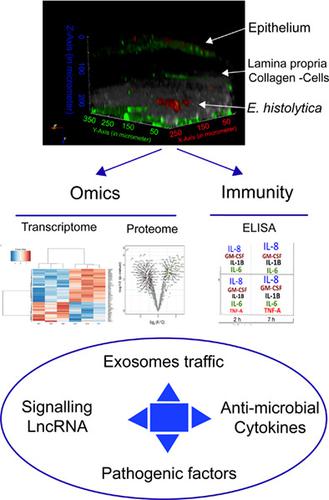当前位置:
X-MOL 学术
›
Cell. Microbiol.
›
论文详情
Our official English website, www.x-mol.net, welcomes your
feedback! (Note: you will need to create a separate account there.)
Insights into amebiasis using a human 3D-intestinal model.
Cellular Microbiology ( IF 2.6 ) Pub Date : 2020-03-16 , DOI: 10.1111/cmi.13203 Arturo Aguilar-Rojas 1, 2 , Silvia Castellanos-Castro 1, 3 , Mariette Matondo 4 , Quentin Giai Gianetto 4, 5 , Hugo Varet 5, 6 , Odile Sismeiro 5 , Rachel Legendre 5, 6 , Julien Fernandes 7 , David Hardy 8 , Jean-Yves Coppée 5 , Jean-Christophe Olivo-Marin 1 , Nancy Guillen 9, 10
Cellular Microbiology ( IF 2.6 ) Pub Date : 2020-03-16 , DOI: 10.1111/cmi.13203 Arturo Aguilar-Rojas 1, 2 , Silvia Castellanos-Castro 1, 3 , Mariette Matondo 4 , Quentin Giai Gianetto 4, 5 , Hugo Varet 5, 6 , Odile Sismeiro 5 , Rachel Legendre 5, 6 , Julien Fernandes 7 , David Hardy 8 , Jean-Yves Coppée 5 , Jean-Christophe Olivo-Marin 1 , Nancy Guillen 9, 10
Affiliation

|
Entamoeba histolytica is the causative agent of amebiasis, an infectious disease targeting the intestine and the liver in humans. Two types of intestinal infection are caused by this parasite: silent infection, which occurs in the majority of cases, and invasive disease, which affects 10% of infected persons. To understand the intestinal pathogenic process, several in vitro models, such as cell cultures, human tissue explants or human intestine xenografts in mice, have been employed. Nevertheless, our knowledge on the early steps of amebic intestinal infection and the molecules involved during human–parasite interaction is scarce, in part due to limitations in the experimental settings. In the present work, we took advantage of tissue engineering approaches to build a three‐dimensional (3D)‐intestinal model that is able to replicate the general characteristics of the human colon. This system consists of an epithelial layer that develops tight and adherens junctions, a mucus layer and a lamina propria‐like compartment made up of collagen containing macrophages and fibroblast. By means of microscopy imaging, omics assays and the evaluation of immune responses, we show a very dynamic interaction between E. histolytica and the 3D‐intestinal model. Our data highlight the importance of several virulence markers occurring in patients or in experimental models, but they also demonstrate the involvement of under described molecules and regulatory factors in the amoebic invasive process.
中文翻译:

使用人类 3D 肠道模型深入了解阿米巴病。
溶组织内阿米巴 是阿米巴病的病原体,阿米巴病是一种针对人类肠道和肝脏的传染病。这种寄生虫会引起两种肠道感染:大多数情况下发生的无症状感染和影响 10% 感染者的侵袭性疾病。为了了解肠道致病过程,已经采用了几种体外模型,例如细胞培养物、人体组织外植体或小鼠人体肠道异种移植物。然而,我们对阿米巴肠道感染的早期步骤和人与寄生虫相互作用所涉及的分子的了解很少,部分原因是实验环境的限制。在目前的工作中,我们利用组织工程方法构建了一个三维 (3D) 肠道模型,该模型能够复制人类结肠的一般特征。该系统由形成紧密和粘附连接的上皮层、粘液层和由含有巨噬细胞和成纤维细胞的胶原蛋白组成的固有层状隔室组成。通过显微成像、组学分析和免疫反应评估,我们展示了一种非常动态的相互作用。E. histolytica和 3D 肠道模型。我们的数据强调了患者或实验模型中出现的几种毒力标记的重要性,但它们也证明了未描述的分子和调节因子参与了阿米巴侵入过程。
更新日期:2020-03-16
中文翻译:

使用人类 3D 肠道模型深入了解阿米巴病。
溶组织内阿米巴 是阿米巴病的病原体,阿米巴病是一种针对人类肠道和肝脏的传染病。这种寄生虫会引起两种肠道感染:大多数情况下发生的无症状感染和影响 10% 感染者的侵袭性疾病。为了了解肠道致病过程,已经采用了几种体外模型,例如细胞培养物、人体组织外植体或小鼠人体肠道异种移植物。然而,我们对阿米巴肠道感染的早期步骤和人与寄生虫相互作用所涉及的分子的了解很少,部分原因是实验环境的限制。在目前的工作中,我们利用组织工程方法构建了一个三维 (3D) 肠道模型,该模型能够复制人类结肠的一般特征。该系统由形成紧密和粘附连接的上皮层、粘液层和由含有巨噬细胞和成纤维细胞的胶原蛋白组成的固有层状隔室组成。通过显微成像、组学分析和免疫反应评估,我们展示了一种非常动态的相互作用。E. histolytica和 3D 肠道模型。我们的数据强调了患者或实验模型中出现的几种毒力标记的重要性,但它们也证明了未描述的分子和调节因子参与了阿米巴侵入过程。











































 京公网安备 11010802027423号
京公网安备 11010802027423号